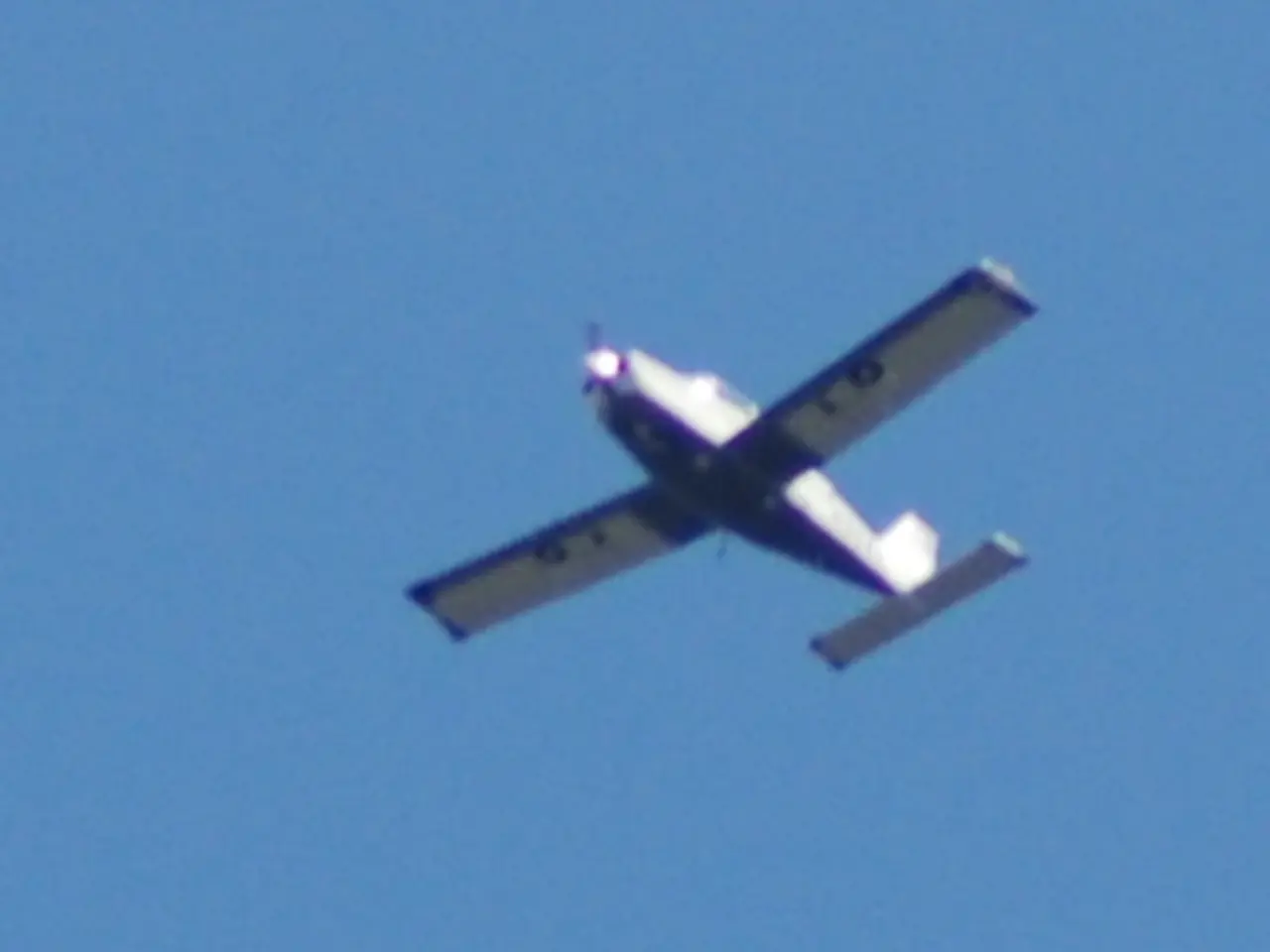B-21 Bomber's Top Commander Announces Second Flight in Short Timeframe
The U.S. Air Force is set to significantly expand the production of its B-21 Raider bombers, aiming for around seven aircraft per year at peak capacity. This decision comes in response to a changing global environment and the importance of long-range strike capabilities.
The $4.5 billion funding boost, approved in a recent reconciliation bill, is earmarked specifically for accelerating B-21 production capacity [1][2]. This increase will enable Northrop Grumman, the manufacturer of the B-21, to sustain or potentially increase the original production rate of seven or eight aircraft annually under Low-Rate Initial Production (LRIP) [4].
Discussions between Northrop Grumman and the Air Force are ongoing regarding further production ramp-up and investment to expand capacity, although detailed final production numbers beyond the annual rate of about seven have not been publicly disclosed [2].
The B-21 program is moving swiftly, with at least two B-21s scheduled for flight testing in 2026. These aircraft are designed to be nearly combat-ready, allowing for swift deployment if necessary [3][5].
The B-21 is set to build upon the success of its predecessor, the B-2 Spirit, while advancing some of its capabilities. Lessons learned from the B-2's initial and upgraded capabilities have been incorporated into the design of the B-21. Additionally, low observables maintenance lessons from over three decades have been integrated into the B-21's design and materials [6].
Maintainers and pilots of the B-2 have been embedded with acquisition engineers and industry partners to optimize various aspects of the B-21. The bomber is also designed to be certified for both nuclear and conventional missions from the outset, unlike the B-2 [7].
The first B-21 flew in November 2023, and Northrop Grumman's aeronautics president, Tom Jones, stated that the first aircraft is flying approximately two times per week. The number of B-21 aircraft on the production line is classified, but at least six are in some stage of construction [8].
The Air Force aims to acquire more than 100 B-21 aircraft, with some support for increasing the production to 145 aircraft [9]. The design philosophy for the B-21 is evolutionary, not aiming for a generational leap. The increase in production capacity is being analysed by Northrop Grumman, Air Force Materiel Command, and Headquarters Air Force [10].
Early in 2024, former Pentagon acquisition and sustainment chief William LaPlante stated that the low production rate of the B-21 was intentional to protect it from budget cuts [11]. However, the urgency to replace aging bombers and enhance long-range strike capabilities has led to this recent decision to increase production capacity.
The B-21 Raider is poised to revolutionise long-range strike capabilities, building upon the success of the B-2 Spirit while advancing its capabilities to meet the needs of the modern battlefield.
References:
[1] Starr, S. (2022, April 28). House approves $4.5 billion for B-21 bomber production. Defense News. https://www.defensenews.com/air/2022/04/28/house-approves-4-5-billion-for-b-21-bomber-production/
[2] Keller, M. (2022, April 28). House OKs $4.5 billion for B-21 bomber production, but details about how it will be spent remain murky. Air Force Times. https://www.airforcetimes.com/news/your-air-force/2022/04/28/house-oks-4-5-billion-for-b-21-bomber-production-but-details-about-how-it-will-be-spent-remain-murky/
[3] Shields, A. (2022, April 28). House approves $4.5 billion for B-21 bomber production. Inside Defense. https://insidedefense.com/inside-defense/daily-report/house-approves-4-5-billion-for-b-21-bomber-production/
[4] Keller, M. (2022, April 28). House OKs $4.5 billion for B-21 bomber production, but details about how it will be spent remain murky. Air Force Times. https://www.airforcetimes.com/news/your-air-force/2022/04/28/house-oks-4-5-billion-for-b-21-bomber-production-but-details-about-how-it-will-be-spent-remain-murky/
[5] Starr, S. (2022, April 28). House approves $4.5 billion for B-21 bomber production. Defense News. https://www.defensenews.com/air/2022/04/28/house-approves-4-5-billion-for-b-21-bomber-production/
[6] Keller, M. (2022, April 28). House OKs $4.5 billion for B-21 bomber production, but details about how it will be spent remain murky. Air Force Times. https://www.airforcetimes.com/news/your-air-force/2022/04/28/house-oks-4-5-billion-for-b-21-bomber-production-but-details-about-how-it-will-be-spent-remain-murky/
[7] Keller, M. (2022, April 28). House OKs $4.5 billion for B-21 bomber production, but details about how it will be spent remain murky. Air Force Times. https://www.airforcetimes.com/news/your-air-force/2022/04/28/house-oks-4-5-billion-for-b-21-bomber-production-but-details-about-how-it-will-be-spent-remain-murky/
[8] Jones, T. (2022, April 28). Northrop Grumman's aeronautics president discusses the B-21 Raider's progress. Air Force Magazine. https://www.airforcemag.com/dr-tom-jones-discusses-the-b-21-raiders-progress/
[9] Keller, M. (2022, April 28). House OKs $4.5 billion for B-21 bomber production, but details about how it will be spent remain murky. Air Force Times. https://www.airforcetimes.com/news/your-air-force/2022/04/28/house-oks-4-5-billion-for-b-21-bomber-production-but-details-about-how-it-will-be-spent-remain-murky/
[10] Keller, M. (2022, April 28). House OKs $4.5 billion for B-21 bomber production, but details about how it will be spent remain murky. Air Force Times. https://www.airforcetimes.com/news/your-air-force/2022/04/28/house-oks-4-5-billion-for-b-21-bomber-production-but-details-about-how-it-will-be-spent-remain-murky/
[11] LaPlante, W. (2024, February 1). Interview with William LaPlante. Aviation Week & Space Technology. https://www.aviationweek.com/defense/interview-william-laplante
- The United States Air Force aims to increase the production of its B-21 Raider bombers, with a goal of seven aircraft annually at peak capacity, due to a changing global environment and the importance of long-range strike capabilities.
- The recent increase in funding, $4.5 billion, specifically allocated for accelerating B-21 production, will allow Northrop Grumman to sustain or potentially increase the original production of seven or eight aircraft per year under Low-Rate Initial Production (LRIP).
- As the B-21 program moves swiftly, with the first aircraft scheduled for flight testing in 2026, discussions are ongoing between Northrop Grumman and the Air Force regarding further production ramp-up and investments to expand capacity.
- The B-21 Raider is set to build upon the success of its predecessor, the B-2 Spirit, while advancing capabilities and incorporating lessons learned from the B-2's initial and upgraded capabilities, along with maintenance lessons from over three decades, into the design of the B-21.
- Maintainers, pilots of the B-2, acquisition engineers, and industry partners have collaborated on optimizing various aspects of the B-21, with the bomber designed to be certified for both nuclear and conventional missions from the outset.
- The production of the B-21 Raider, poised to revolutionize long-range strike capabilities, is being analyzed by Northrop Grumman, Air Force Materiel Command, and Headquarters Air Force, with the potential for expanding production beyond the initial goal of 100 aircraft.







